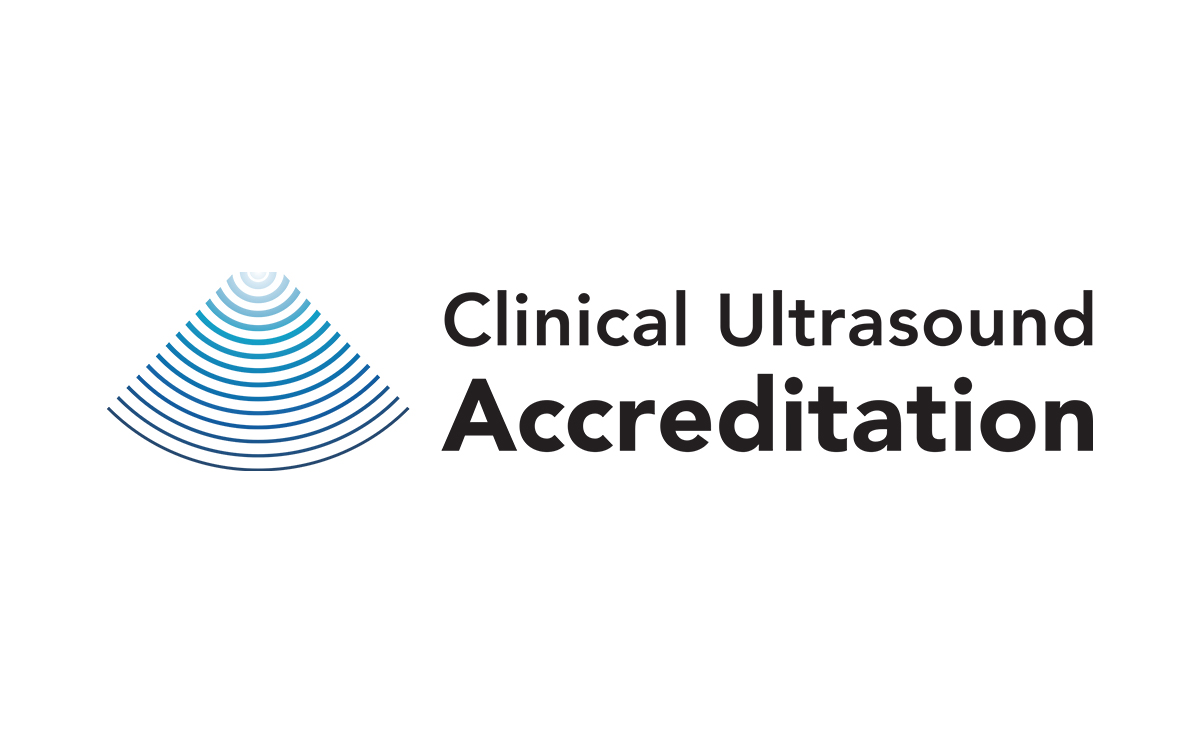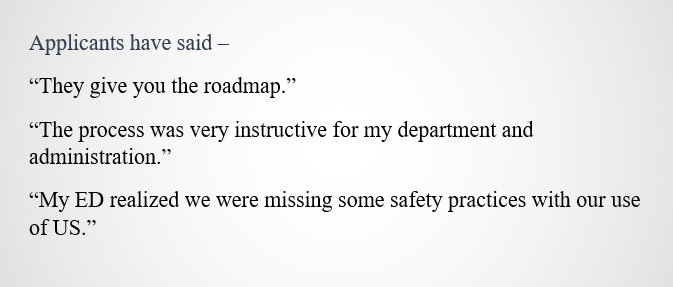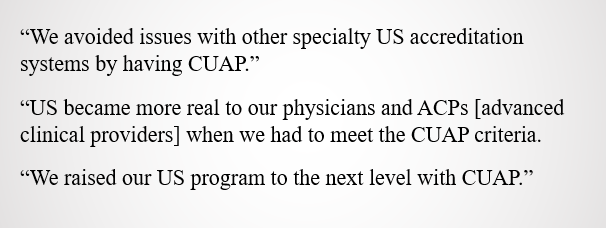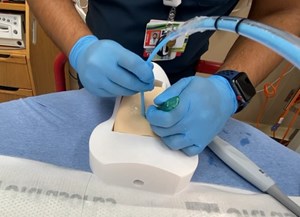
Take Your Ultrasound Program to the Next Level with CUAP
By Vivek S. Tayal, MD, FACEP and Jim Villareal, MD, FACEP
The ECRI Institute, a nonprofit organization that evaluates health care technology, published a report of the “Top 10 Medical Technology Hazards for 2020.” In this report, point-of-care ultrasound (US) was listed as the #2 hazard. According to the report, “a lack of oversight regarding the use of point-of-care ultrasound (POCUS)—including when to use it and how to use it—may place patients at risk and facilities in jeopardy.” The report goes on to state: “Policies and procedures should address institution-wide concerns, including user training and credentialing, exam documentation, and data archiving. And they should address specialty-specific issues, such as developing exam protocols that conform to established guidelines and recommendations.”
These are standards that ACEP has advocated for since approving the first comprehensive US guidelines in 2001—and this is what the Clinical Ultrasound Accreditation Program (CUAP) is all about.
Ultrasound in emergency medicine has grown over the last two decades, with applications for every human body part and condition, machines with various size and technological prowess, networking technology, dedicated reporting software, training at every level of medical education, and use in every part of the globe. Medical students, residents, fellows, physician assistants, emergency medical services, nurses, other medical specialties, US device manufacturers, regulatory bodies, other US organizations, and patients all look to EM as the inception and home of point-of-care clinical US.
As emergency physician–performed US becomes more ubiquitous, your US program represents a significant component of the “signature” of your EM group in the eyes of hospital leadership and other stakeholders. Many emergency departments have made the effort to invest in US machines, US-trained physicians, US software, and US education. Well-managed US programs have processes in place that address workflow, continuous quality improvement, and patient safety. Can that investment in your US program make US more meaningful to your group, your hospital, and your practice?

CUAP is an emergency point-of-care US accreditation program that was approved by the ACEP Board in 2008 and became the first successful EM accreditation program in 2015. CUAP was created by emergency physicians to be a simple, quality-based process for emergency US program accreditation. CUAP incorporates functional criteria such as safety, quality assurance, education, and management towards accreditation.
ED directors and US directors may wonder if their program is ready for CUAP accreditation. This quick list may suggest you’re ready to apply:
Does your EM group have?
- An US director
- Credentials for at least one emergency US application
- US reporting in the medical record
- US quality assurance
- US machine institutional engineering review
- US cleaning protocols
- US education for staff
If you have these US program elements, you are ready to apply for CUAP.
The application process is based on the fundamentals of ACEP’s Emergency US Guidelines. Consider the CUAP application process as a “virtual” consultant to help you improve your program and polish your application as you get feedback from a team of expert emergency US physicians who will work with you to achieve successful accreditation.
How to apply:
- Go to http://www.cuap.org and click on the “Apply Now” emblem.
- The Getting Started page loads with a list of templates, available in Word or PDF format, to assist you in creating policies and documents that satisfy CUAP accreditation requirements.
- Customize the CUAP templates or use your own forms for your department’s US program.
- Using the Getting Started page’s list, finish the work of formalizing your program in accordance with ACEP US Guidelines.
- Once you have your policies, complete your application by uploading your department’s policies in PDF format.
- CUAP staff at ACEP will review your application and send it to reviewers.
- Two reviewers, both emergency physicians with expertise in US program management, will review your submission for clarity, consistency, safety, and compliance.
- Any issues will be brought to your attention, and resolution usually occurs quickly.
- The CUAP Board then reviews the application and votes on accreditation. The process usually takes a few months.
We welcome your application as we strive to ensure the best emergency US practices for our patients and communities. Take your ultrasound program to the next level with CUAP accreditation.

Common Misconceptions about CUAP
- US programs are assumed and not a big deal anymore. The exploding use of US makes it a prime focus for review in health care systems from competence of providers to machines safety, infection control, quality assurance, and accountability. The public is aware of the technological advances in US and expects a safe US program.
- We don’t bill for US so we don’t need CUAP. If you are using US for any diagnostic, procedural guidance, or treatment reason, US is part of your emergency care. Meeting national EM guidelines is expected, regardless of billing.
- CUAP is only for large academic programs. CUAP was designed for all EDs, ranging from the small critical-access hospital to the large tertiary care center. The US program criteria are the same for all, regardless of size, location, or educational mission.
- We don’t perform all the US applications mentioned in the ACEP Ultrasound Guidelines. Even if your program performs just one application, such as procedural guidance or focused assessment with sonography in trauma (FAST), you still should address issues of quality, safety, and training. CUAP can help you achieve this standard.
- Our ED director is our US director. We realize that, in small groups or EDs, roles may be shared. We want the US director to understand the issues associated with US use in the ED.
- Our images/reports are not digital. While most emergency departments have changed to digital images and reports in the electronic medical record, we recognize that there are settings and situations that utilize different media.
- We don’t use endocavitary probes or transesophageal echo (TEE) in our practice. Most EM US use is surface use, and even that use has safety requirements. Internal probe use like endovaginal US or TEE is not mandatory for CUAP accreditation. We encourage any emergency department to pursue endovaginal pregnancy US or TEE cardiac imaging as your program matures.
- We don’t have a high-level disinfection (HLD) program. The vast majority of emergency ultrasound exams that use external transducers do not need a HLD program. However, US performed within body cavities (endocavitary or TEE) does require an appropriate HLD program.
- Our practice is spread across several hospitals. We recognize that some groups staff multiple hospitals and yet function under the same US leadership and policies. These types of programs are offered discounts for their additional facilities.
- We don’t have enough money for accreditation. The cost of accreditation for an ED is very reasonable ($1,500 for the primary site) and has not increased since inception.
- US fellowship programs don’t need CUAP because they will have separate accreditation. All fellowship programs need to train fellows in a safe, high-quality system. That is the mission of CUAP. While US fellowship programs may not be required by the American Board of Emergency Medicine to be CUAP accredited, any EM fellowship program that has made the effort to achieve CUAP accreditation has also demonstrated a sincere interest in promoting their program’s focus on quality, safety, and training.
- Our hospital does not care about US accreditation. A safe, high-quality practice that meets nationally-recognized standards is always noticed by hospital system administration and can make your US program and your ED appreciated, respected, and protected.
- CUAP application is going to take too long. Once you have your checklist of program policies and descriptions ready, it only takes an hour to finish the application. You need to get the policies approved locally, but we make it as simple as possible with templates and sample documents. There is no cost to start the application process on the CUAP website, and you finish the application as you gather, complete, and upload the required forms and policies. Payment is the last step of submission.



